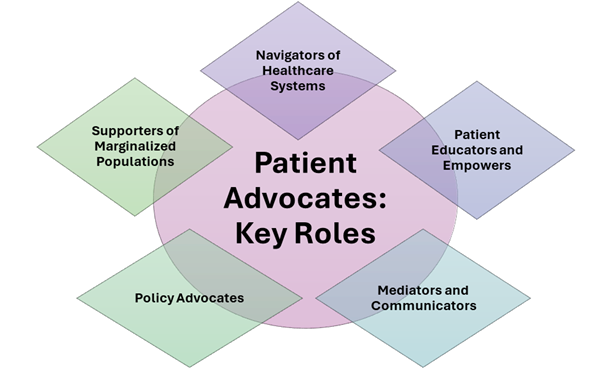
Overview
Patient advocacy is central to modern healthcare, ensuring patient voices shape care decisions. In CPD, integrating patient advocates enhances education, improves provider communication and optimizes care outcomes. Despite these benefits, they remain underutilized. This paper explores their roles, challenges and strategies for effective inclusion in CPD.
Introduction
Patient advocates often emerge from personal experiences navigating healthcare for themselves or loved ones. As healthcare shifts toward patient-centered models, integrating patient voices into CPD ensures that educational programs reflect real-world challenges and foster more empathetic, effective learning.
As healthcare continues to take steps toward more patient-centered models, the inclusion of patient voices in the planning and execution of CPD activities ensures that care remains aligned with patient needs and experiences. By involving patient advocates, the CPD community can create more relevant, empathetic and effective educational opportunities for healthcare professionals (Institute of Medicine, Redesigning Continuing Education in the Health Professionals, 2010).
While a patient advocate may serve in many different roles of a patient’s journey, the overall goal of patient advocate is to provide patients and caregivers with the support and education they need so they can make their own decisions about their next steps. Advocates have the patient's back (like a “wingman”) and help make their journey through the healthcare system as smooth as possible (The Joint Commission, 2025).
Key Roles of Patient Advocates
Patient advocates are individuals who actively represent and address the needs and rights of patients within healthcare systems. Their roles are diverse and essential for ensuring equitable, compassionate and efficient care. Figure 1 illustrates some of the many vital roles patient advocates can assume.
Figure 1. Patient Advocate Key Roles

- Navigators of Healthcare Systems: Patient advocates guide individuals through complex healthcare systems, ensuring that patients access appropriate resources, understand their treatment options, and effectively navigate insurance processes (Natale-Pereira, Enard, Nevarez, & Jones, 2011).
- Educators and Empowerees: Advocates educate patients about their rights, treatment options and the importance of informed consent. By empowering patients to actively participate in their care, they promote better health outcomes (Williamson, 2025).
- Mediators and Communicators: Advocates serve as intermediaries between patients and healthcare providers, fostering clear communication and helping resolve misunderstandings. This role is particularly crucial for patients with language barriers or low health literacy (Sisti, 2024).
- Policy Advocates: Advocates educate patients on rights, treatment options and informed consent, empowering them to make informed healthcare decisions (Williams, Phillips, & Koyama, 2018).
- Supporters of Marginalized Populations: Policy advocates influence healthcare regulations and policies, addressing issues such as accessibility, affordability and equity (Horvat, Horey, Romois, & Kis-Rigo, 2014).
The Importance of Patient Advocacy in CPD
Enhancing Patient-centered Education
Patient advocates bring lived experiences to CPD, reinforcing the importance of patient-centered care. Their involvement fosters empathy, improves communication and strengthens the provider-patient relationship, leading to better clinical outcomes (Institute of Medicine, Crossing the Quality Chasm: A New Health System for the 21st Century, 2001; National Academies of Sciences, Engineering, and Medicine, 2017; The Beryl Institute, 2024).
Enhancing Relevance and Practicality
CPD activities often focus on clinical and technical competencies. Incorporating patient perspectives into the planning process ensures that educational content is relevant to real-world challenges, providing healthcare providers with actionable insights to address patient concerns. (Berwick, 2009)
Supporting Accreditation and Standards
Accreditation bodies such as the Accreditation Council for Continuing Medical Education (ACCME) emphasize the inclusion of patient-centered approaches in CPD programs. Incorporating patient advocacy aligns with these requirements and supports the development of compliant, impactful educational initiatives. (Accreditation Council for Continuing Medical Education, 2020).
Incorporating Patient Advocacy Into a CPD Program
To maximize the impact of CPD, patient advocates should be involved in both planning and implementation. Below are key strategies for integrating them effectively.
Integrating Patient Advocates in CPD Development
- Curriculum Development and Content Creation: Including patient advocates on CPD planning committees ensures that programs address patient priorities and focus on real-world challenges. Advocates can identify gaps in care delivery that healthcare professionals may overlook. (Towle, et al., 2021) Patient advocates enhance CPD curricula by aligning content with real-world patient needs. Their collaboration with educators ensures diverse, relevant and impactful learning materials for healthcare providers.
- Interprofessional Collaboration and Diversity Representation: Patient advocates can function as bridges between healthcare teams and the patient community, fostering interprofessional collaboration and understanding. Their insights encourage a holistic approach to care. Patient advocates from varied backgrounds provide valuable perspectives on cultural, social and economic factors that influence health outcomes. This promotes inclusivity and cultural competence in CPD programs.
- Voices for Systemic Change: Beyond individual care, patient advocates highlight systemic issues in healthcare delivery, encouraging CPD programs to address broader challenges such as health disparities, access to care and policy implications.
- Evaluation and Feedback: Patient advocates can offer critical feedback on CPD programs, assessing whether they adequately prepare healthcare professionals to meet patient needs. This feedback can guide the refinement of future educational initiatives.
Integrating Patient Advocates in CPD Delivery
- Narrative-based Learning: Patient stories and case studies provide powerful tools for teaching empathy, communication and problem-solving. These narratives can be included in lectures, workshops, panel discussions and e-learning modules. This creates an open dialogue between patients and healthcare professionals, fostering mutual understanding and collaboration. (Loy & Kowlasky, 2024)
- Role in Simulation Training: Advocates can participate in simulation-based learning exercises, helping healthcare professionals practice addressing patient concerns and preferences in a safe environment. (Elundu, et al., 2024)
- Cultural Competency Workshops: Advocates from diverse backgrounds can contribute to cultural competency training, educating healthcare providers on social, economic and cultural factors that influence health outcomes. (Horvat, et al., 2014)
Reliable Sources for Identifying Patient Advocates
To successfully integrate patient advocacy into CPD, identifying credible and experienced advocates is essential. While not an exhaustive list, Table 1 and Table 2 provide some reliable resources:
Table 1. Patient Advocacy Organizations
Table 2. Community-Based Resources
|
Resource
|
Description
|
|
Patient and Family Advisory Councils (PFACs)
|
Many hospitals and health systems host PFACs where patient advocates collaborate with healthcare teams.
|
|
Local Health Boards and Nonprofits
|
Community organizations often connect with patient advocates focused on local healthcare needs. Hospital systems also have patient advocacy and patient resources as part of their care plans.
|
Conclusion
Patient advocacy is a critical component of CPD, enriching educational programs with perspectives grounded in lived experiences. By involving patient advocates in the planning and implementation of CPD activities, healthcare professionals gain insights into patient-centered care, communication and cultural competence. Reliable organizations, community resources and online platforms provide accessible avenues to identify experienced advocates. Through these collaborations, CPD programs can better equip healthcare providers to meet the complex needs of their patients, fostering empathy, improving outcomes and advancing healthcare equity.
Patient advocates bring invaluable perspectives that enhance CPD, fostering empathetic, patient-centered care. Their inclusion should not be optional but integral to CPD design and implementation. By embracing this approach, CPD can drive meaningful improvements in healthcare education and delivery.
References
Accreditation Council for Continuing Medical Education. (2020). Standards for integrity and indepence in accredited continuing education. Retrieved December 3, 2024, from https://www.accme.org
Berwick, D. (2009). What "patient-centered" should mean: Confessions of an externist. Health Affairs, 28(4), w555-w565.
Elundu, etal. (2024). The impact of simulation-based training in medical education: A Review. Medicine, 103(27).
Epstein, R., & Street, J. R. (2011). The values and value of patient-centered care. Ann Fam Medicine.
Horvat, L., Horey, D., Romois, P., & Kis-Rigo, J. (2014). Cultural competence education for health professionals. Cochraine Database Systematic Review.
Institute of Medicine. (2001). Crossing the Quality Chasm: A New Health System for the 21st Century. National Acadmies Press.
Institute of Medicine. (2010). Redisigning Continuing Education in the Health Professionals. Retrieved from https://www.ncbi.nlm.nih.gov/books/NBK219811/pdf/Bookshelf_NBK219811.pdf
Loy, M., & Kowlasky, R. (2024). Narrative MEdicine: The Power of Shared Stories to Enhances Inclusive Clinical Care, Clinical Well Being and MEdical Education. Permante journal, 28(23), 116.
Natale-Pereira, etal. (2011, Aug). The role of patient navigators in eliminating health disparities. Cancer, 117(Suppl 15), 3543-52.
National Academies of Sciences, Engineering, and Medicine. (2017). Crossing the Global Quality Chasm: Improving Health Care Worldwide. National Academies Press.
Sisti, C. (2024, January 31). Biotethcs Today. Retrieved from Patient Advocacy in Practice: https://bioethicstoday.org/blog/patient-advocacy-in-practice/
The Beryl Institute. (2024). Stories that Transform: A Guide to Storytelling in Healthcare. Retrieved February 26, 2025, from https://theberylinstitute.org/wp-content/uploads/2024/10/TBI_Storytelling_Guidebook.pdf
The Joint Commission. (2025). Use an Advoate or Be an Advocate for Others. Retrieved February 26, 2025, from https://www.jointcommission.org/resources/for-consumers/take-charge/use-an-advocate-or-be-an-advocate-for-others/
Towle, A., Tajani, S., Beamish, L., & Bluman, B. (2021). Patient Partners in Continuing Professional Development: Experience Developing an End-of-Life Care Progra for Family Physicians. Journal of Continuing Education in the Health Professions, 41(4), 273-278.
Williams, S., Phillips, J., & Koyama, K. (2018). Nursing Advocacy: Adopting a Health in All Policies APrroach. OJIN: Online Journal of Issues in Nursing, 23(No 3), Manuscript 1.
Williamson, K. (2025). Empowering Patients: The Role fo Advocacy in Healthcare Transformation. Retrieved from American Hospital & Healthcare Managment: https://www.americanhhm.com/articles/empowering-patients-the-role-of-advocacy-in-healthcare-transformation

Heather Ranels, CHCP, FACEHP, is a leader in continuing professional education with expertise in accredited program development, learner engagement, and education technology. With over 20 years of experience, she designs strategic curricula, drives accreditation excellence and collaborates with stakeholders to enhance professional learning. She is actively involved in the Alliance and currently serves as vice chair of the Almanac.